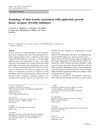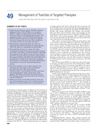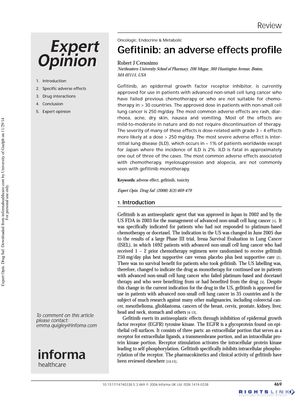TLDR Gefitinib can cause skin problems, diarrhea, and nausea, but rarely causes severe lung disease or hair loss.
Gefitinib, used for advanced non-small cell lung cancer, has common adverse effects including rash, diarrhea, acne, dry skin, nausea, and vomiting, which are generally mild-to-moderate and do not necessitate stopping treatment. These side effects tend to be dose-related, with more severe grade 3 – 4 effects occurring at doses above 250 mg/day. A particularly serious side effect is interstitial lung disease (ILD), with a global incidence of approximately 1%, but higher in Japan at 2%. ILD can be fatal in about 33% of cases. Unlike chemotherapy, gefitinib does not commonly cause myelosuppression or alopecia.
116 citations
,
December 2003 in “Acta Dermato Venereologica” Iressa often causes skin issues like acne and dryness in lung cancer patients.
169 citations
,
September 2002 in “British journal of dermatology/British journal of dermatology, Supplement” ZD1839 (Iressa) causes skin and hair side effects, treatable with tretinoin cream and minocycline.
87 citations
,
March 2013 in “Expert Review of Anticancer Therapy” Afatinib often causes skin problems that need proactive management.
 38 citations
,
February 2012 in “Supportive Care in Cancer”
38 citations
,
February 2012 in “Supportive Care in Cancer” Skin problems like acne, dry skin, and nail and hair changes are common in patients taking EGFR inhibitors.
5 citations
,
April 2016 in “PubMed” Cetuximab often causes skin problems, but they can be managed without stopping treatment.
 2 citations
,
January 2018 in “Elsevier eBooks”
2 citations
,
January 2018 in “Elsevier eBooks” Targeted therapies for lung cancer are effective but require careful management of side effects to benefit patients.
12 citations
,
May 2015 in “Journal of the National Comprehensive Cancer Network” Doctors should actively prevent and treat skin side effects in cancer patients to keep them on the best medication and reduce discomfort.


